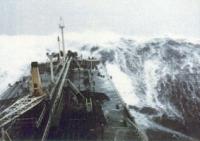 In the last day or two, there have been numerous press reports of a 19 meter (62.3 ft) wave, recorded by an automated buoy in the North Atlantic between Iceland and the UK off the Outer Hebrides. This is a new record for a wave recorded by a buoy.
In the last day or two, there have been numerous press reports of a 19 meter (62.3 ft) wave, recorded by an automated buoy in the North Atlantic between Iceland and the UK off the Outer Hebrides. This is a new record for a wave recorded by a buoy.
What does this really mean? Rogue waves are often larger than 19 meters. The first scientifically reported rogue, the Draupner wave, which struck a drilling platform of the same name on New Year’s Day in 1995, was recorded to be 25.6 metres (84 ft) high. So why is a 19 meter wave such a big deal?
The best answer may be that there are different sorts of waves and they are measured differently. Automated buoys generally cannot accurately measure rogue waves. They are designed to measure the overall seastate. What makes the 19 meter wave so remarkable is that it was not a single wave but an average of a series of waves.
Technically, the World Meteorological Organization expert committee which reviewed the event called it “the highest significant wave height as measured by a buoy”. The WMO World Weather Climate Extremes Archive explains that “significant wave height” is “in essence, what an observer would have seen if he/she averaged over 15-20 waves passing by the buoy.”
So, an average wave height of 19 meters of a series of waves is rather remarkable. Or was remarkable. The WMO announcement about the new record significant wave height was released yesterday. The waves themselves were recorded in February 2013.
But what about rogue waves? They are something quite different. Often called “freak” waves, they do not fit the standard wave models and are generally explained using quantum physics, specifically the nonlinear Schrödinger equation. If you are familiar with Schrödinger’s cat, a rogue might be called Schrödinger’s wave.
Rogue waves are often defined as waves whose height is more than twice the significant wave height. If conditions were right for the formation of a rogue wave in a sea with a 19 meter significant wave height, that would an impressive wave indeed.
Thanks to Alaric Bond for contributing to this post.

That is quite the story lag. Recorded in 2013 and posted in 2016?
Interesting, a similar post that has been doing the rounds on Facebook here in Ireland and on Coast Monkey.
I came across this one – http://www.met.ie/marine/marine_map.asp – about a wave recorded off the Irish coast by Buoy M4, 44NM off the Donegal Coast, so well into the N Atlantic. It was an individual wave height as opposed to the scary average in your post but at 23.4m it was a whopper.
That NW corner of Ireland is apparently world famous in the surfing community for monster waves, both inshore and offshore.